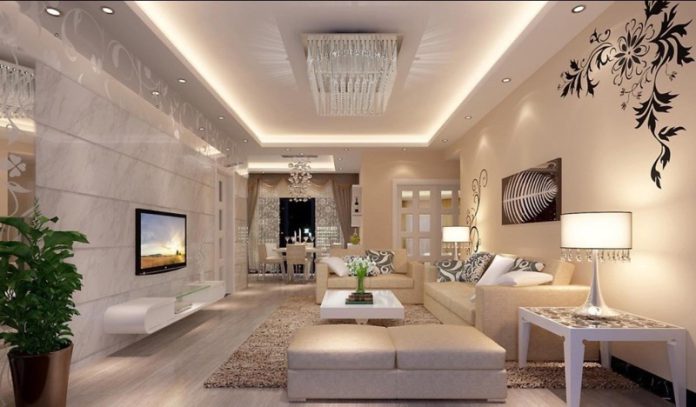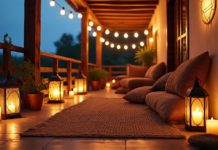How do you feel when you first walk into your home? You work hard for your lifestyle, and your house shouldn’t cause added stress after a long day. When you create a room where the atmosphere is peaceful and calming or happy and welcoming, you want to be there.
If your house isn’t doing this for you yet, an easy and inexpensive way to solve the problem is to change the lighting. Yes, a lighting trick could be all you need to create the perfect atmosphere in every room of your home.
How can you do this? Well, it’s not magic, but it might seem like it is. Depending on what’s going on in the room, one or more lighting tricks could instantly turn your home from stressful to restful.
1. Recognize the Problem
There’s a reason why styles like feng shui are popular worldwide. The energy and atmosphere in a room change when you adjust the color, space, and texture flow. All of these design elements matter. How your room is put together might be the problem.
Is your furniture too big or too small for the size of the room? Are there too many colors or textures clashing together? Are you aiming for minimalistic but hitting the mark and going too simplified, or doing the opposite and you’re a tad too eclectic or Bohemian?
Adjusting the lighting can make a difference no matter what’s going on in a room. While you’re attempting to get the style under control, try skipping the bright, glaring ceiling lights. Use floor or table lamps or WarmDim downlights instead. These hide the disconcerting elements and let you relax when you enter a room.
2. Match the Lighting to the Activity
Is your bedroom lighting too bright, or are your kitchen lights too dull? Lighting has an effect on a person’s mood. Studies show that lights do more than help you to see images, intensities, shapes, and contrasts. Various types of lighting produce biological and psychological changes in our bodies.
Lighting can positively or negatively affect a person, as we see with SAD (Seasonal Affective Disorder). Too much darkness plays havoc with our circadian rhythm and eventually causes depression and sadness.
However, there’s a time and place for everything, including darkness. Your bedroom is the place you go to when you’re ready to sleep, so it should be dark in there.
Take out the overhead lightbulbs, replace them with warm options, and use a table lamp on your nightstand. Save the bright lights for the kitchen and other rooms where you want to be active and alert.
3. Use Layering
Layering isn’t solely for textures. When you layer your lighting, you make use of a variety of light sources at different levels.
For instance, you might want to use one bright overhead light in a large room. But that makes it cold and glaring instead of warm and welcoming. Instead, opt for pendant lighting to hang from the ceiling, then use table lamps or standing corner lamps to chase the shadows away from the room’s edges.
4. Get Rid of Unnecessary Lighting
Do you really need those bright lights in every room? Ceiling lights come standard in most homes today because it’s simply easier to walk into a room and flick a switch. Let there be light!
But the lightbulbs that are in the room aren’t set in stone. You can change them out or get rid of them completely. If you need more or less light, make it happen. The light in a room should be useful. If it’s too strong, it’s using energy that you don’t need. So, if you’re not using a particular light to its capacity, change to energy-efficient bulbs, strip lighting, or another lower wattage style.
5. Pay Attention to the Bulbs
Not only are bulbs potentially costing you money on your power bill, but they’re also stealing your peace. Look at the wattage on each lightbulb. In rooms where you want to be alert and productive, use bulbs with higher temperatures and watts. In other areas, such as the bedroom or living room, opt for lower temperature bulbs.
If your aim is to be energy efficient, there are lightbulbs that will say this on the outside of the package. LED white lighting is currently the most energy-efficient bulb on the market, using up to 90% less energy. They also tend to last 25 times longer than old-school incandescent bulbs.
You can use light bulbs to make a design statement, too. For instance, if you want your room to emit a relaxing red atmosphere, put a low-watt red bulb in your table lamp. Some people use LED strip lighting in multiple colors to create this effect.
6. Hide the Flaws, Show Off the Favorites
Is there a gash in the wall you are tired of looking at or an area that needs to be repainted … eventually?
You could make use of paintings and framed pictures to cover these flaws. Or, let the right lighting be your strategy to hide them.
To do this, simply take the lighting away from those areas and move it to show off the places of the room you do like. So, if the overhead lighting is so bright that it’s easy to see the areas that cause you to stress, turn off that bright light. Grab a WarmDim downlight or a corner lamp, and place it near something you don’t mind showing off.
This strategy also works well when your furniture is stained or shabby. If you can’t replace your couch yet or buy a cover, move the lighting! Like magic, it’s not as visible anymore.
7. Avoid Accidents With Lighting
Is someone in your home accident-prone? It happens to the best of us, from toddlerhood to senior citizens. When you need a midnight snack, or you get up in the middle of the night to use the bathroom, what path do you take? Instead of turning on the lights in each room and waking yourself up even more, use directional floor-level lighting or a well-placed nightlight.
8. Don’t Overdo It
Regardless of how many unique interior design elements you have in each room of the house, try to stay consistent with your lighting. Aim for natural lighting when possible. Choose pendant lighting, table lamps, and corner lamps that complement each other.
Stick with the same dimmer switches or recessed lighting throughout the house. You’ll help guests avoid confusion, and make it easier on you when it’s time to replace bulbs or light switches.















